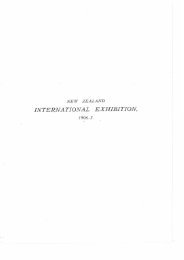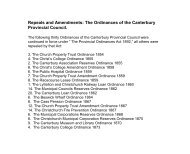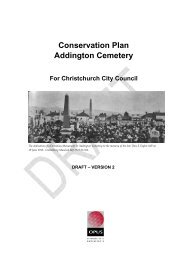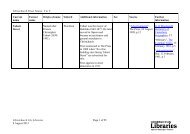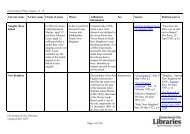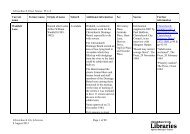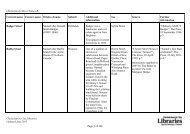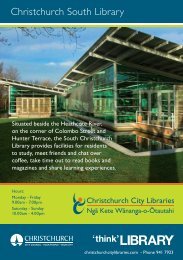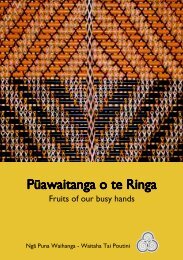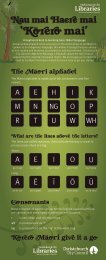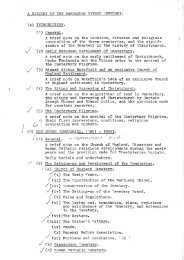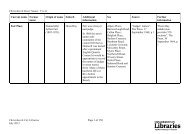Rich man, poor man, environmentalist, thief - Christchurch City ...
Rich man, poor man, environmentalist, thief - Christchurch City ...
Rich man, poor man, environmentalist, thief - Christchurch City ...
Create successful ePaper yourself
Turn your PDF publications into a flip-book with our unique Google optimized e-Paper software.
Mrs Mahomet (left), her daughters and fur trader,<br />
Mrs Singh<br />
42<br />
pleasant, therefore, to note that at least one pupil<br />
at St Albans School envied Tulah Mahomet her<br />
‘ro<strong>man</strong>tic’ name. More prosaically, ‘Florence’<br />
was named after her mother.<br />
Such was the success of the ice-cream business<br />
that, in 1907, Sali was able to purchase land at 69<br />
Caledonian Road and erect a single storey<br />
dwelling. Built of kauri, the structure had a bay<br />
window, decorative woodwork in the hall and<br />
ornate rose patterns in the ceiling. Sali’s house<br />
was, and remains, a desirable residence. At a time<br />
when electricity reached only as far as Bealey<br />
Avenue, Sali had a lead extended to a large wooden<br />
outhouse, the ‘dairy,’ where, with fastidious<br />
cleanliness, he made his ice-cream. At first a horse and cart<br />
and, later, a truck brought one hundred weight blocks of ice<br />
from the Canterbury Frozen Meat Company. Slabs were<br />
packed about the product in the ‘dairy’ and Sali undertook<br />
the onerous task of breaking up ice with a mallet so that chips<br />
could be used to keep the product cool as it was being<br />
transported to the Square. A youthful neighbour caught the<br />
horse which pulled Sali’s cart into town. Afterwards it was<br />
towed in by a Blue Star taxi.<br />
Sali dispensed his wares between August of one year and<br />
the April that followed, commenting that, during the other<br />
months, ‘you can keep cool without an ice-cream’. However,<br />
he was such a feature of the landscape that there developed a<br />
belief that his was a year-round business. On one occasion a<br />
<strong>man</strong> rang him to settle a bet – whether he was on his stand in<br />
June and July. Locals regarded him as part of the scenery when<br />
the weather was warm and, with poetic licence, described the<br />
‘appearance of Mr Mahomet and his ice-cream... as the official<br />
beginning of summer’. It might, more appropriately, have been<br />
called the first hint of spring.<br />
Wholesale druggist H F Stevens made ‘Ice-cream Charlie’s’<br />
pineapple, strawberry, raspberry and orange flavoured syrups<br />
and also his vanilla essence which came from beans imported<br />
by Sali and roasted at home in his coal range oven. Other<br />
ingredients included eggs, cornflour, milk and cream, the two<br />
latter being provided by the Tai Tapu Dairy Company. The<br />
ice-cream was made before dawn, at first in a hand-operated<br />
churn and, later, in an American import, a Westinghouse<br />
machine which could produce four separate batches at once.<br />
Vanilla ice-cream was sold in tub-shaped cones. Essenceflavoured<br />
sundaes came in glass dishes with silver spoons (these<br />
were washed and re-used). There were also small and large<br />
take-home packs. At the end of a long day in town, <strong>man</strong>y a<br />
small but well-behaved child was rewarded with one of the<br />
ice-cream seller’s products. Sali’s wares cost between one<br />
penny and one shilling.<br />
Cartoon of Sali Mahomet, Press, 28 January 1939<br />
Most locals smiled on the exotic intruders. On special<br />
occasions they would call with a billy or preserving jar to<br />
purchase ice-cream. At Christmas, St Albans people,<br />
orphanages and the lunatic asylum were treated to copious<br />
amounts of Sali’s product.



